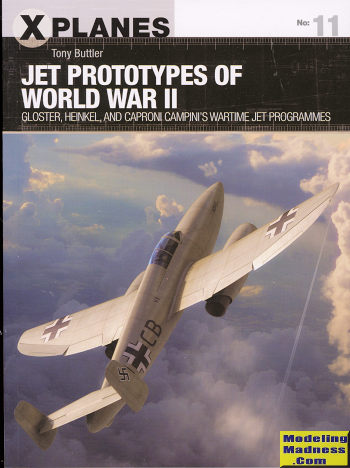 A major
development of WWII was the jet engine. In most cases this meant one of two
types of turbojet engine; the centrifugal and the axial flow engine, both of
which are still in use today. However, not all jets fit into these two
categories as there was a ducted fan jet that turned out to be a dead end.
A major
development of WWII was the jet engine. In most cases this meant one of two
types of turbojet engine; the centrifugal and the axial flow engine, both of
which are still in use today. However, not all jets fit into these two
categories as there was a ducted fan jet that turned out to be a dead end.
Not surprisingly, the Germans were the first to fly a turbo
jet, the first to develop a jet fighter and though outside the scope of this
book, the first to use them in combat. As many of you know, engine development
in Germany, the UK, and Italy proceeded fairly independently of each other. The
British and German designs were the ones that were eventually developed while
the Italian engine never went past two prototype aircraft. It turns out that the
British went with the simpler centrifugal design while the Germans concentrated
their effors on the more complex, but more powerful axial flow engine. It was
the Italians who tested and rejected the ducted fan.
The book concentrates on four aircraft. The German entries
are the first jet aircraft, the He-178 and the first jet fighter, the He-280.
The former was a very small experimental aircraft that was designed only to
prove the viability of the design. it used a combination engine that had a axial
flow impeller and centrifugal flow compressor to provide the needed power. The
later He-280 used axial flow engines and was a private venture that was
ultimately rejected by the Luftwaffe, but the various prototypes went on to be
excellent test aircraft for various systems. As a note, the He-280 was fitted
with a compressed air ejection seat and was actually used by one of the test
pilots to save his life when a prototype went out of control.
The British developed the E28/39 to test Whittle's
centrifugal flow engine. There were two prototypes build and they were used
extensively as test aircraft for a number of years. More and more powerful and
reliable engines were fit and this allowed the exploration of the engine's
operating envelope. It was a true test aircraft in all meanings of the term. The
Gloster was only retired when more powerful Meteor aircraft became available to
take the testing to a new level.
Finally, we have the Italian version, the Caproni-Campini
CC.2. This was basically a ducted fan with an afterburner. It used a standard
aero engine to drive the various compressors that gave it thrust. Fuel was then
sprayed into the exhaust and ignited to provide even more thrust. However, that
thrust was fairly small even with the afterburning. The aircraft's claims to
fame were that it was the first two seat jet and the first to fly cross country.
Other than that it was rife with development delays and its mediocre performance
proved that the propulsion system was not the way to go.
In all, this is a great read. The author has been writing
about prototypes and 'what if' aircraft for a very long time so has researched
these subjects considerably. Add to it some great period photos of planes and
personalities along with some equally good art work and you have a book that I
can easily recommend to you.
July 2019
Copyright ModelingMadness.com. All rights reserved.
Thanks to Osprey Publishing for the review book. For more on the complete line of Osprey books,
visit www.ospreypublishing.com
.
If you would like your product reviewed fairly and fairly quickly, please contact
the editor or see other details in the
Note to
Contributors.
 A major
development of WWII was the jet engine. In most cases this meant one of two
types of turbojet engine; the centrifugal and the axial flow engine, both of
which are still in use today. However, not all jets fit into these two
categories as there was a ducted fan jet that turned out to be a dead end.
A major
development of WWII was the jet engine. In most cases this meant one of two
types of turbojet engine; the centrifugal and the axial flow engine, both of
which are still in use today. However, not all jets fit into these two
categories as there was a ducted fan jet that turned out to be a dead end.